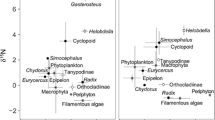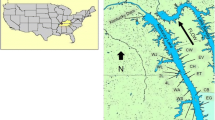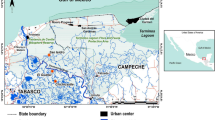Abstract
Invasive species are one of the widespread stressors of aquatic ecosystems. Several studies document food web effects of invasive fish, but little information is available on the effects of invasive macrophytes. We studied differences in food chain length as well as trophic position and trophic diversity of fish and odonates in lakes dominated by native plants or invasive Eurasian watermilfoil. Trophic position and food chain length were determined using baseline-adjusted δ15N isotope signatures. Trophic diversity, or isotope niche width, was estimated from convex hull area analysis. Results show that trophic position of secondary consumers was not affected by the invasive macrophyte, whereas trophic diversity was greater in watermilfoil-dominated lakes. The direction of isotopic niche expansion was different in fish and odonates, suggesting potential decoupling in predator–prey interactions. This study shows that dominant non-native macrophytes may cause significant changes in food web structure of invaded ecosystems. Trophic diversity may be a more sensitive indicator of environmental stress than trophic position and has the potential to be used for assessment of invasive species impacts and restoration success.


Similar content being viewed by others
References
Blois, C., 1985. Diets and resource partitioning between larvae of three anisopteran species. Hydrobiologia 126: 221–227.
Britton, J. R., G. D. Davies & C. Harrod, 2010. Trophic interactions and consequent impacts of the invasive fish Pseudorasbora parva in a native aquatic foodweb: a field investigation in the UK. Biological Invasions 12: 1533–1542.
Carpenter, S. R. & D. M. Lodge, 1986. Effects of submersed macrophytes on ecosystem processes. Aquatic Botany 26: 341–370.
Carvalheiro, L. G., Y. M. Buckley & J. Memmott, 2010. Diet breadth influences how the impact of invasive plants is propagated through food webs. Ecology 91: 1063–1074.
D’Antonio, C. M. & S. E. Hobbie, 2005. Plant species effects on ecosystem processes. In Sax, D. E., J. J. Stachowicz & S. D. Gaines (eds), Species Invasions: Insights into Ecology, Evolution, and Biogeography, 65–84.
Dibble, E. D. & S. L. Harrel, 1997. Largemouth bass diets in two aquatic plant communities. Journal of Aquatic Plant Management 35: 74–78.
Folsom, T. C. & N. C. Collins, 1984. The diet and foraging behavior of the larval dragonfly Anax junius (Aeshnidae), with an assessment of the role of refuges and prey activity. Oikos 42: 105–113.
Fry, B., 1991. Stable isotope diagrams of freshwater food webs. Ecology 72(6): 2293–2297.
Hammer, Ø., D. A. T. Harper & P. D. Ryan, 2001. PAST: Paleontological Statistics Software Package for Education and Data Analysis. Palaeontologia Electronica 4: 9 [available on internet at http://palaeo-electronica.org/2001_1/past/issue1_01.htm]. Accessed 10 July 2010.
Hoeinghaus, D. J., K. O. Winemiller & A. A. Agostinho, 2008. Hydrogeomorphology and river impoundment affect food-chain length of diverse Neotropical food webs. Oikos 117: 984–995.
Jeppesen, E., M. Søndergaard, M. Søndergaard & K. Christoffersen (eds), 1997. The Structuring Role of Submerged Macrophytes in Lakes. Ecological Studies, Vol. 131. Springer, NY: 423.
Johansson, F., 1993. Intraguild predation and cannibalism in odonate larvae: effects of foraging behaviour and zooplankton availability. Oikos 66: 80–87.
Kelly, D. J. & I. Hawes, 2005. Effects of invasive macrophytes on littoral-zone productivity and foodweb dynamics in a New Zealand high-country lake. Journal of the North American Benthological Society 24: 300–320.
Kim, G. W. & D. R. DeVries, 2001. Adult fish predation on freshwater limnetic fish larvae: a mesocosm experiment. Transactions of the American Fisheries Society 130: 189–203.
Kovalenko, K., E. D. Dibble & R. Fugi, 2009. Fish feeding in changing habitats: effects of invasive macrophyte control and habitat complexity. Ecology of Freshwater Fish 18: 305–313.
Kovalenko, K. E., E. D. Dibble & J. Slade, 2010. Community effects of invasive macrophyte control: role of invasive plant abundance and habitat complexity. Journal of Applied Ecology 47: 318–328.
Layman, C. A., D. A. Arrington, C. G. Montaña & D. M. Post, 2007a. Can stable isotope ratios provide for community-wide measures of trophic structure? Ecology 88(1): 42–48.
Layman, C. A., J. P. Quattrochi, C. M. Peyer & J. E. Allgeier, 2007b. Niche width collapse in a resilient top predator following ecosystem fragmentation. Ecology Letters 10: 937–944.
Mittelbach, G. G., 1981. Foraging efficiency and body size: a study of optimal diet and habitat use by bluegills. Ecology 62: 1370–1386.
Neff, B. D., 2003. Paternity and condition affect cannibalistic behavior in nest-tending bluegill sunfish. Behavioral Ecology and Sociobiology 54: 377–384.
Post, D. M. & G. Takimoto, 2007. Proximate structural mechanisms for variation in food-chain length. Oikos 116: 775–782.
Pritchard, G., 1964. The prey of dragonfly larvae (Odonata; Anisoptera) in ponds in Northern Alberta. Canadian Journal of Zoology 42: 785–800.
Robinson, J. V. & G. A. Wellborn, 1987. Mutual predation in assembled communities of odonate species. Ecology 68(4): 921–927.
Romanuk, T. N., B. E. Beisner, N. D. Martinez & J. Kolasa, 2006. Non-omnivorous generality promotes population stability. Biology Letters 2: 374–377.
Simon, K. S. & C. R. Townsend, 2003. Impacts of freshwater invaders at different levels of ecological organisation, with emphasis on salmonids and ecosystem consequences. Freshwater Biology 48: 982–994.
Skogerboe, J. G. & K. D. Getsinger, 2006. Selective Control of Eurasian Watermilfoil and Curlyleaf Pondweed Using Low Doses of Endothall Combined with 2,4-D. ERDC/TN APCRP-CC-05. U.S. Army Engineer Waterways Experiment Station, Vicksburg, MS.
Thompson, D. J., 1978. The natural prey of larvae of the damselfly, Ischnura elegans (Odonata: Zygoptera). Freshwater Biology 8: 377–384.
Vander Zanden, M. J., G. Cabana & J. B. Rasmussen, 1997. Comparing trophic position of freshwater fish calculated using stable nitrogen isotope ratios (δ15N) and literature dietary data. Canadian Journal of Fisheries and Aquatic Sciences 54: 1142–1158.
Vander Zanden, M. J., J. M. Casselman & J. B. Rasmussen, 1999a. Stable isotope evidence for the food web consequences of species invasions in lakes. Nature 401: 464–467.
Vander Zanden, M. J., B. J. Shuter, N. Lester & J. B. Rasmussen, 1999b. Patterns of food chain length in lakes: a stable isotope study. American Naturalist 154: 406–416.
Washington State Department of Ecology, 2001a. Herbicide Risk Assessment for the Aquatic Plant Management Final Supplemental Environmental Impact Statement Appendix C, Volume 3: 2,4D. Publication Number 00-10-043, 299 [available on internet at http://www.ecy.wa.gov/pubs/0010043.pdf]. Accessed 19 Nov 2010.
Washington State Department of Ecology, 2001b. Herbicide Risk Assessment for the Aquatic Plant Management Final Supplemental Environmental Impact Statement Appendix D, Volume 2: Endothall. Publication Number 00-10-044, 299 [available on internet at http://www.ecy.wa.gov/pubs/0010044.pdf]. Accessed 19 Nov 2010.
Wetzel, R. G., 2001. Limnology: Lake and River Ecosystems, 3rd ed. Academic Press, San Diego, CA: 1006.
Wilcove, D. S., D. Rothstein, J. Dubow, A. Phillips & E. Losos, 1998. Quantifying threats to imperiled species in the United States. BioScience 48(8): 607–615.
Acknowledgments
We are grateful to Matthew Spickard, Krisan Webb, Jean Chervenak, and Dan Dugan for their assistance with data collection, Matt Roberts for suggestions on isotope analysis, and Gary Ervin, John Madsen, and Todd Tietjen for insightful comments on the earlier version of this manuscript. Financial support for this study was kindly provided by the Department of Wildlife and Fisheries, Mississippi State University and the Aquatic Ecosystem Restoration Foundation.
Author information
Authors and Affiliations
Corresponding author
Additional information
Handling editor: M. Power
Rights and permissions
About this article
Cite this article
Kovalenko, K.E., Dibble, E.D. Effects of invasive macrophyte on trophic diversity and position of secondary consumers. Hydrobiologia 663, 167–173 (2011). https://doi.org/10.1007/s10750-010-0570-7
Received:
Revised:
Accepted:
Published:
Issue Date:
DOI: https://doi.org/10.1007/s10750-010-0570-7




